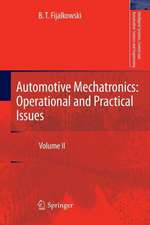The Reality of the Artificial: Nature, Technology and Naturoids: Studies in Applied Philosophy, Epistemology and Rational Ethics, cartea 4
Autor Massimo Negrottien Limba Engleză Paperback – 18 iul 2014
The development of naturoids may be viewed as a distinct class of technological activity, and the concept should be useful for methodological research into establishing the common rules, potentialities and constraints that characterize the human effort to reproduce natural objects. The author shows that a naturoid is always the result of a reduction of the complexity of natural objects, due to an unavoidable multiple selection strategy. Nevertheless, the reproduction process implies that naturoids take on their own new complexity, resulting in a transfiguration of the natural exemplars and their performances, and leading to a true innovation explosion. While the core performances of contemporary naturoids improve, paradoxically the more a naturoid develops the further it moves away from its natural counterpart. Therefore, naturoids will more and more affect our relationships with advanced technologies and with nature, but in ways quite beyond our predictive capabilities.
The book will be of interest to design scholars and researchers of technology, cultural studies, anthropology and the sociology of scienceand technology.
| Toate formatele și edițiile | Preț | Express |
|---|---|---|
| Paperback (1) | 639.20 lei 6-8 săpt. | |
| Springer Berlin, Heidelberg – 18 iul 2014 | 639.20 lei 6-8 săpt. | |
| Hardback (1) | 643.50 lei 6-8 săpt. | |
| Springer Berlin, Heidelberg – 7 iun 2012 | 643.50 lei 6-8 săpt. |
Din seria Studies in Applied Philosophy, Epistemology and Rational Ethics
- 20%
 Preț: 603.90 lei
Preț: 603.90 lei -
 Preț: 397.59 lei
Preț: 397.59 lei -
 Preț: 359.54 lei
Preț: 359.54 lei - 20%
 Preț: 989.96 lei
Preț: 989.96 lei - 24%
 Preț: 787.50 lei
Preț: 787.50 lei -
 Preț: 390.08 lei
Preț: 390.08 lei -
 Preț: 370.88 lei
Preț: 370.88 lei - 15%
 Preț: 641.20 lei
Preț: 641.20 lei - 20%
 Preț: 991.60 lei
Preț: 991.60 lei - 20%
 Preț: 646.95 lei
Preț: 646.95 lei - 15%
 Preț: 653.98 lei
Preț: 653.98 lei -
 Preț: 384.48 lei
Preț: 384.48 lei -
 Preț: 395.47 lei
Preț: 395.47 lei - 18%
 Preț: 1216.95 lei
Preț: 1216.95 lei - 18%
 Preț: 947.50 lei
Preț: 947.50 lei -
 Preț: 388.72 lei
Preț: 388.72 lei -
 Preț: 390.08 lei
Preț: 390.08 lei -
 Preț: 395.09 lei
Preț: 395.09 lei -
 Preț: 394.12 lei
Preț: 394.12 lei - 15%
 Preț: 644.82 lei
Preț: 644.82 lei - 15%
 Preț: 698.15 lei
Preț: 698.15 lei - 18%
 Preț: 1840.91 lei
Preț: 1840.91 lei - 20%
 Preț: 656.84 lei
Preț: 656.84 lei -
 Preț: 389.70 lei
Preț: 389.70 lei - 20%
 Preț: 991.46 lei
Preț: 991.46 lei - 15%
 Preț: 585.73 lei
Preț: 585.73 lei - 15%
 Preț: 711.40 lei
Preț: 711.40 lei - 15%
 Preț: 589.33 lei
Preț: 589.33 lei - 15%
 Preț: 700.42 lei
Preț: 700.42 lei
Preț: 639.20 lei
Preț vechi: 799.00 lei
-20% Nou
Puncte Express: 959
Preț estimativ în valută:
122.33€ • 127.24$ • 100.99£
122.33€ • 127.24$ • 100.99£
Carte tipărită la comandă
Livrare economică 14-28 aprilie
Preluare comenzi: 021 569.72.76
Specificații
ISBN-13: 9783642443534
ISBN-10: 3642443532
Pagini: 168
Ilustrații: VIII, 160 p.
Dimensiuni: 155 x 235 x 9 mm
Greutate: 0.25 kg
Ediția:2012
Editura: Springer Berlin, Heidelberg
Colecția Springer
Seria Studies in Applied Philosophy, Epistemology and Rational Ethics
Locul publicării:Berlin, Heidelberg, Germany
ISBN-10: 3642443532
Pagini: 168
Ilustrații: VIII, 160 p.
Dimensiuni: 155 x 235 x 9 mm
Greutate: 0.25 kg
Ediția:2012
Editura: Springer Berlin, Heidelberg
Colecția Springer
Seria Studies in Applied Philosophy, Epistemology and Rational Ethics
Locul publicării:Berlin, Heidelberg, Germany
Public țintă
ResearchCuprins
Part I.- Chap. 1 Daedalus and Icarus.- Chap. 2 Artificiality and Naturoids.- Chap. 3 Duplicating Reality.- Part II.- Chap. 4 The First Step: Observation.- Chap. 5 Observation and Representations.- Chap. 6 The Exemplar and Its Definition.- Chap. 7 Essentiality of Things.- Part III.- Chap. 8 The Mind Reduces Complexity, Reality Does Not Make Discounts.- Chap. 9 The Problem of Synthesis.- Chap. 10 Transfiguration.- Part IV.- Chap. 11 Classification of the Artificial.- Chap. 12 Automatisms and Naturoids.- Chap. 13 Naturoids in Real Contexts: Bionic Man and Robots.- Chap. 14 The Challenge of Complexity.- Chap. 15 Illusion and Compatibility.- Part V.- Chap. 16 Naturoids: Interface and Camouflage.- Chap. 17 Structure or Process?.- Chap. 18 Artificial Limbs: History and Current Trends.- Chap. 19 The Artificial Brain.- Chap. 20 Prostheses, Replacements and Surrogates.- Chap. 21 Artificial Environments and Landscapes.- Chap. 22 Virtual Reality.- Chap. 23 Conclusions.- Appendix A Naturoids and Music.- Sect. A.1 Reproduction and Transfiguration.- Sect. A.2 The Rarefaction of Meaning.- Sect. A.3 Statements by Writers or Scholars in the Humanities.- Sect. A.4 Statements by Composers.- Appendix B Naturoids and Conventional Technology Devices.- References.
Recenzii
"This book presents an interesting and deep discussion of some of the principle problems of artificial reality. The point of view of the author ... will help computer science readers broaden their understanding of the classical vision of the subject. ... The book presents an interesting approach for the interpretation of artificial reality and artificial things." (Pietro Hiram Guzzi, Computing Reviews, November 14, 2012)
Notă biografică
Massimo Negrotti has been a full professor of the Methodology of Human Sciences at the Universities of Parma and Genoa since 1980, and currently also teaches at the Università di Urbino 'Carlo Bo', where he chairs the LCA (Lab for the Culture of the Artificial). His areas of research are methodology of human sciences, technology, cybernetics, and the culture of the artificial.
Textul de pe ultima copertă
The human ambition to reproduce and improve natural objects and processes has a long history, and ranges from dreams to actual design, from Icarus’s wings to modern robotics and bioengineering. This imperative seems to be linked not only to practical utility but also to our deepest psychology. Nevertheless, reproducing something natural is not an easy enterprise, and the actual replication of a natural object or process by means of some technology is impossible. In this book the author uses the term naturoid to designate any real artifact arising from our attempts to reproduce natural instances. He concentrates on activities that involve the reproduction of something existing in nature, and whose reproduction, through construction strategies which differ from natural ones, we consider to be useful, appealing or interesting.
The development of naturoids may be viewed as a distinct class of technological activity, and the concept should be useful for methodological research into establishing the common rules, potentialities and constraints that characterize the human effort to reproduce natural objects. The author shows that a naturoid is always the result of a reduction of the complexity of natural objects, due to an unavoidable multiple selection strategy. Nevertheless, the reproduction process implies that naturoids take on their own new complexity, resulting in a transfiguration of the natural exemplars and their performances, and leading to a true innovation explosion. While the core performances of contemporary naturoids improve, paradoxically the more a naturoid develops the further it moves away from its natural counterpart. Therefore, naturoids will more and more affect our relationships with advanced technologies and with nature, but in ways quite beyond our predictive capabilities.
The book will be of interest to design scholars and researchers of technology, cultural studies, anthropology and the sociology of science andtechnology.
The development of naturoids may be viewed as a distinct class of technological activity, and the concept should be useful for methodological research into establishing the common rules, potentialities and constraints that characterize the human effort to reproduce natural objects. The author shows that a naturoid is always the result of a reduction of the complexity of natural objects, due to an unavoidable multiple selection strategy. Nevertheless, the reproduction process implies that naturoids take on their own new complexity, resulting in a transfiguration of the natural exemplars and their performances, and leading to a true innovation explosion. While the core performances of contemporary naturoids improve, paradoxically the more a naturoid develops the further it moves away from its natural counterpart. Therefore, naturoids will more and more affect our relationships with advanced technologies and with nature, but in ways quite beyond our predictive capabilities.
The book will be of interest to design scholars and researchers of technology, cultural studies, anthropology and the sociology of science andtechnology.
Caracteristici
Interesting for design scholars and researchers of technology, cultural studies, anthropology and the sociology of science and technology Naturoids affect our relationships with advanced technologies and with nature in ways beyond our predictive capabilities Author is an authority on the methodology of human sciences, technology, cybernetics, and the culture of the artificial Includes supplementary material: sn.pub/extras













